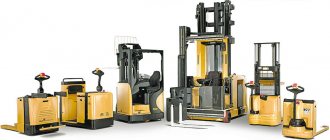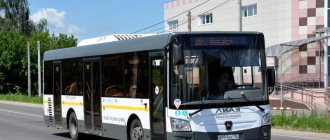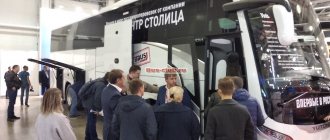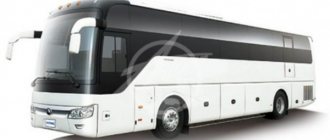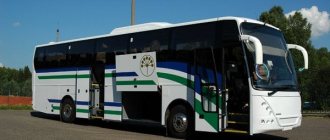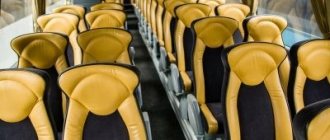Tourist (excursion) bus Hyundai Universe with a capacity of 43+1. Photo YarCamp
Modern buses are a popular type of transport for transporting organized groups of tourists over long distances . Manufacturers offer buses that are so comfortable, equipped with all the options necessary for passenger comfort, that they successfully compete with other types of transport . Therefore, tourist buses are in high demand. This article is devoted to the types of vehicle data.
Features of vehicles, interior, differences from excursion ones
Tourist buses are designed to provide a comfortable ride. Much attention is paid to the body design and interior equipment . In terms of its equipment, as well as its purpose, tourist transport has many similarities with intercity buses. In addition, it is worth noting that many experts do not see the difference between excursion and tourist class buses. In principle, it is advisable to use tourist transport for short excursion trips. At the same time, for tourist trips that are significant in time and distance, using equipment for excursions is not a good idea. In addition, there are universal models designed for tourist and excursion trips.
Tourist bus NEFAZ-52999. Photo UralSpetsTrans
Characteristics of comfortable cars
A modern tourist bus has the following distinctive characteristics :
- excellent visibility is provided by panoramic windows;
- the presence of two doors, characterized by small dimensions and located in the front and middle parts of the body;
- increased base length;
- availability of a specially equipped place for a guide;
- spacious luggage compartments;
- no standing room;
- equipping the interior with comfortable seats with adjustable parameters;
- the presence of additional equipment, the list of which depends on the class of the car, providing increased comfort: heating and air conditioning system, kitchen, toilet and others; the presence of certain amenities is often displayed on the rear window or other part of the bus body through pictograms listing the equipment installed for the comfort of tourists;
- buses operating on regular routes are equipped with a stencil (plate) indicating the place of departure and arrival.
In addition, transport must ensure passenger safety , which implies the operation of serviceable vehicles. The owner must ensure that the vehicle undergoes regular technical inspection, maintenance and repairs.
Modern models are equipped with additional mirrors and rear-view cameras for better visibility.
Scheme of tourist models
There are a large number of vehicle modifications on the modern market, differing not only in the number of seats, but also in their arrangement . There is no single scheme that is standard for all manufacturers and models. Therefore, manufacturers and carriers equip the interior at their own discretion .
Interior diagram of the MAZ-251 tourist bus. Photo MAZ
Therefore, equipment of the same model, modification and year of manufacture may have a different seat layout and different seat numbering from each other. The only requirement is that there is no violation of safety rules.
Seats by the door: advantages and disadvantages
It would seem that the seats closer to the exit are safer and there is a chance of being the first to get out of the cabin. But these chairs by the door are very tricky.
If the trip is planned for the cold season (autumn, winter, early spring), then passengers in these seats will constantly be blown by cold air currents every time the door is opened and closed. But in the hot summer season this place can be considered a big plus.
The seats on the right side of the cabin, right in front of the door in the middle of the cabin, do not recline. This is logical so that the reclining seat backs do not interfere with the free passage of passengers to the street. Usually, such seats are much cheaper than other seats on the same bus, and the buyer does not immediately understand what the catch is and the reason for such a discount.
If you plan to take a lot of photographs directly from the cabin, then it is most comfortable to take photos from seats near the window or in the aisle, but in the front rows - here the view is the best.
Classification, types
Tourist buses are distinguished not only by their high popularity, but also by their variety of types. Specialists are constantly working on creating new models, offering more and more choice to customers. Several criteria are used to classify transport; detailed information about the parameters and types is presented below.
How many seats do buses have: regular and other?
Bus is a category of vehicle that can accommodate 9 or more passengers. Most often, only intercity and tourist buses are divided into groups based on capacity; on city and other types of transport, “scattering” in cabin capacity is rare. The site provides the following classification by capacity:
- Especially small ones. No more than 10 passengers can comfortably sit in the cabin; the length of the body does not exceed 6 meters.
- Small ones. The salon can accommodate no more than 20 people, the total number of passengers is no more than 40, the length of the body is 6-8 meters.
- Average. The length is up to 10 meters, the number of seated passengers is no more than 30, the total capacity is up to 60 people.
- Big ones. The total capacity is 90 people, the number of seats does not exceed 40, the length of the body is up to 12 meters.
- Particularly large. Designed to accommodate more than 40 seated and 90 standing passengers. Equipment with a body length of up to 18 meters.
But in different sources it is possible to find different indicators for each category.
How many seats are there in small, large, double-decker and other buses?
Tourist bus HIGER KLQ 6928 Q (35+1+1 seats). Photo RusbusinessAuto
The main criterion for classifying tourist buses is the number of provided (seated) seats:
- Buses of particularly low capacity . Such vehicles include cars that can comfortably accommodate no more than 11 passengers. Gazelle can be cited as an example.
- Small capacity , designed for a maximum of 26 people.
- Medium capacity - this type can accommodate up to 34 passengers.
- Large capacity , allowing up to 45 passengers to be accommodated simultaneously. Famous vehicles of this type are Ikarus; for long trips you can pay attention to Neoplan, MAN, Mercedes, Setra.
- Particularly large capacity vehicles are designed to carry a maximum of 80 passengers. Double-decker cars also fall into this category. However, their capacity exceeds 80 passengers. For example, two-story Neoplans provide a comfortable seating capacity from 86 to 99 passengers (depending on modification). Therefore, two-story models must be considered separately.
Reference. Internet users are interested in models with a capacity of 20, 30, 40, 45, 49 and 50 passengers.
Excursion capacity/capacity, number of seats
Excursion buses, which are the subject of a separate article, are divided into five types, similar to tourist buses, according to capacity.
Dimensions/dimensions: small, large and more
Characteristics such as dimensions and number of seats are directly related to each other. The more seats the interior has, the greater the dimensions (length) of the body. The average width of the body is 2.5, the height (depending on the number of floors) varies from 2.5 to 4.5 meters. According to the body length, there are the following types of tourist buses:
- especially small – no more than 6 meters;
- small – from 6 to 8;
- average – from 8 to 10;
- large – from 10 to 11-12;
- especially large - from 12 to 16.
Vehicles whose dimensions exceed 16 meters have an articulated body structure (shape).
Two-story and others
Buses are divided according to the number of floors into:
- one-story;
- one and a half storey;
- two-story.
Double-decker Yutong ZK6126HGB tourist bus with an open second floor. Yutong Photos
Many customers prefer to choose one-and-a-half-story vehicles due to the following design differences. One-and-a-half-story cars have a floor raised above the driver’s seat, where the seats are located, the space under which is used as luggage compartments. Thus, passengers have a good overview of the surrounding area, and carriers are ready to offer tourists spacious luggage compartments.
Double-decker buses are distinguished by their functionality. Some experts believe that they are more suitable for short trips. At the same time, it should be noted that the presence of two tiers (decks) allows you to place various equipment in the cabin or divide the entire space into separate rooms or zones. On the lower floor it is possible to place a kitchen and dining room, a game room, and sleeping places; on the second floor there is a standard salon with passenger seats.
Reds and so on
When choosing a vehicle, body color does not have any practical purpose, so it all depends on the personal preferences of the buyer. Therefore, manufacturers offer a wide selection of buses.
Fuel, consumption
Different types of fuel can be used to refuel vehicles The vast majority of buses for tourists run on gasoline, diesel fuel, liquefied or compressed natural gas. At the same time, recently manufacturers have begun to offer electric buses operating on electric batteries. The production of such equipment is associated with large financial costs, so they are not yet very widespread.
Different models have different fuel consumption , this parameter is often indicated in the technical characteristics of the vehicle.
Transport class: luxury and so on
Luxury double-decker Neoplan Skyliner tourist bus. Neoplan Photos
The class of tourist buses is determined by the number of stars. The determination of “star rating” is carried out using several parameters, the main one being the pitch (distance) of installing passenger seats. Thus, there are five types of buses:
- 1st class - used for passenger transportation extremely rarely, suitable for short trips within one locality or to the suburbs, have a level of comfort slightly higher than that of city transport; the interval between the seats is 68 cm;
- 2nd class - can be used for intercity and international tourism, the only difference from 1st class equipment is that they have a large pitch between the seats - 72 cm;
- 3rd class - the most popular category of vehicles, they deserve popularity due to their relatively low cost and suitability for long trips; such buses have the following amenities: a refrigerator, a microwave and a coffee maker, seats with two armrests, individual lighting and a folding table for each passenger, a bathroom, the distance between the seats is 77-78 cm;
- 4th class - buses of this type are improved versions of 3rd class transport, equipped with air conditioning, suitable for long trips, the distance between the seats is 83-85 cm;
- 5th class - the most comfortable buses, which have a full kitchen, a full set of audio and video equipment, a wardrobe, a drink dispenser, and also the ability to use mobile communications outside the network coverage area; an information screen is installed in the cabin, which displays the necessary information for passengers information about air temperature, travel time, distance to the nearest settlement, its name, the pitch between seats is 90 cm, such buses are often called “luxury”/“luxury”.
Children's
To transport children to educational and entertainment events, including tourist trips, you should use specially equipped buses, the distinctive feature of which is the yellow color of the body and the corresponding inscriptions. The internal arrangement of the transport ensures the safety and comfort of small passengers.
With toilet
The presence of a bathroom on the bus ensures the convenience of passengers and also saves time spent on the road. The driver will not have to make stops on demand, although the rules for using the toilet may vary depending on its model and capacity. In addition, carriers set their own rules.
Bathroom in the HDH bus model of the TopClass series. Setra Photos
Other criteria
There are other parameters by which classification is performed:
- engine location: front-, central- and rear-engine;
- wheel formula;
- engine location;
- number and volume of luggage compartments;
- modification: northern, southern, mountain.
You can get acquainted with other characteristics of tourist buses on the websites of manufacturers and sellers. Trademarks of tourist buses in demand on the market are presented and analyzed in the corresponding article.
Dangerous and safe places
There is no unambiguous criterion for choosing the best seats on a large bus, because each passenger has his own personal preferences: some like it near the window, some prefer to sit right behind the driver, while others feel seasick in the back of the cabin, etc. According to experienced tourists, when choosing a seat on a bus, several important parameters should be taken into account:
- safe location;
- where is the location relative to the door;
- part of the cabin: front, middle or end.
Let's consider places, first of all, from a safety point of view. Frightening news reports of accidents involving long-distance buses are not only frightening, but also terrifying. Such news appears more and more often in news feeds, because in the event of a collision with a large bus, a large number of people can be injured at once. This does not mean that you should cancel your trip altogether and never ride buses again. This cannot be predicted, but you can play it safe and choose the safest places.
Where on the bus is it potentially dangerous to sit in the event of an accident:
- in the first row, but more dangerous - on the right side of the aisle. A head-on collision with a bus and these passengers are the first to be hit.
- a row of seats at the end of the salon. This location will become critical in the event of a collision from behind, and also during sudden braking there is a huge risk of flying into the aisle from the last seats and getting more injuries;
- Favorite seats are by the window on the left side of the cabin. Due to right-hand traffic, this side of the bus is closest to cars that are driving in the adjacent lane and can fly into oncoming traffic if the impact is on the left side.
Where are the safest seats on a long-distance bus:
- On the right side and in the middle of the cabin. Even in this case, it is better to sit not by the window, but closer to the aisle.
- Seats immediately behind the driver. It is believed that at the time of an accident, the driver can instinctively avoid the impact by turning the cab to the left and exposing the right side to the impact.
Where to buy or rent
Companies specializing in the sale of tourist buses of various types are presented in the corresponding section of our website. In addition to purchasing, clients have the opportunity to rent or lease a vehicle. Companies providing these services are collected in the “Where to rent tourist buses” section. Favorable conditions are provided by companies providing transport leasing services. Re-equipment of vehicles allows you to improve/change the functionality and design of equipment, which is often required by owners. Companies offering refurbishment services are collected in a separate section.
Back row: advantages and disadvantages
Few people like to travel long distances in the very last seats on the bus. And there are several good reasons for this:
- Motion sickness. In the last seats, passengers feel the shaking the most, and this is especially not to the liking of those who suffer from seasickness.
- The backs in the chairs are non-folding. Therefore, there will be no opportunity to unfold the chair and take a little nap on the road or just relax.
- In the case of using a general air conditioner for the entire bus (and not a climate control system), it blows very strongly in the rear seats.
- With the only TV at the very beginning of the cabin, it is hard to see and hear nothing in the back rows. The same applies to the guide during the excursion.
But sometimes tour operators, who understand all the disadvantages of rear seats, sell the last row of 2 seats for the cost of one. In this case, the passenger has the opportunity to somehow fit on two seats and relax.
Double-decker buses: advantages and disadvantages
Some travel agencies use double-decker buses for long trips, which have a completely different seat layout and their own characteristics. In order to make the right choice, it is worth considering all the pros and cons of each floor:
First floor:
- the interior is quite spacious;
- usually there are much fewer passengers here than on the second one;
- there are comfortable tables for a snack or to do your own business on the road;
- within walking distance there is a toilet, a cooler with drinking water, a kitchenette and a refrigerator;
- the salon is a little low and you won’t be able to fully admire the beautiful landscapes from the first floor;
- Since the drivers are on the same level as you, at night they can chat, listen to music, watch a movie while you are trying to sleep.
Second floor:
- panoramic views of all the sights that you pass by;
- in the evening it is quiet enough in the cabin to fully relax, because... drivers are located on the floor below.
- it is not so spacious and even a little cramped for passengers of a larger build;
- the second floor is definitely not suitable for people with disabilities;
- For any needs you will have to go down to the first floor every time.
Minibuses are classified depending on:
- length and capacity;
- maximum permissible transported weight;
- number of available sitting/standing places.
Such means of transportation, following the route, make stops at certain stopping points, in places of greatest concentration of potential passengers. They can transport passenger flows: in high-speed mode - skipping some stops, in express taxi mode - delivering passengers from the starting point to the final point without intermediate stops.


